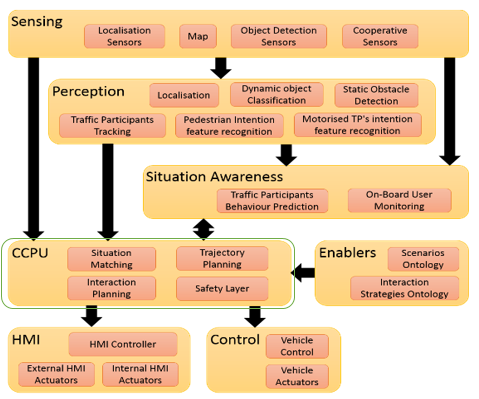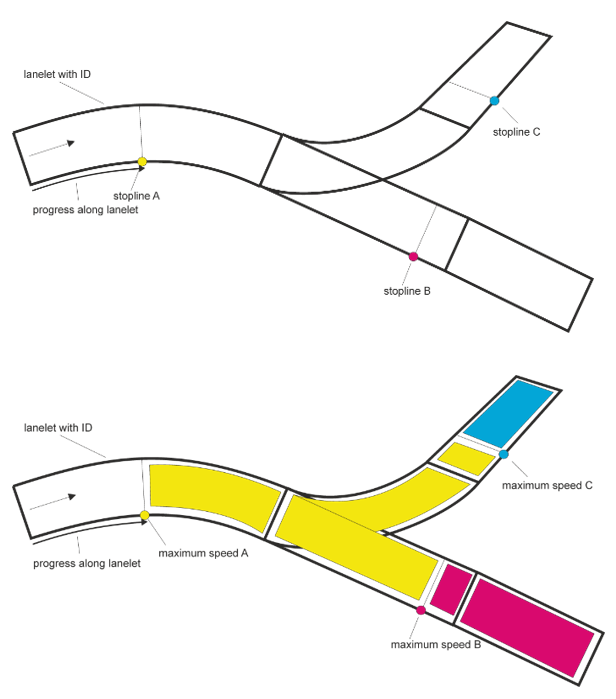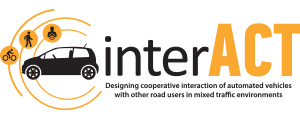Planning the automation – the Cooperation and Communication Unit
Objectives
The Cooperation and Communication Unit (CCPU) is the Automated Vehicles intelligent core: taking into account the kinematics, the gestures and the anticipated behavior of all traffic participants (TPs), the CCPU develops an expectation-conforming, safe plan for the future motion of the Automated Vehicles. Goal of the CCPU is a behavior proposal for the Automated Vehicles, consisting of the decision to give or take way, resulting in the generation of stop lines in front of the vehicle, the minimal and maximal velocity and the decision about the information that should be communicated to surrounding traffic participants via the eHMI.

Figure 1: interACT system architecture and CCPU position in it.
Technical approach
A modular approach to software design was followed, where CCPU’s core components were compartmentalized using virtualization. The main development included: rule-based traffic conflict identification incl. deadlock situation and non-collision courses, fuzzy rule-based Automated Vehicles desision making (stop line, speed constrains), long-term path planning using determenistic models, short-term trajectory planning using Model predictive control strategy and fail-safe trajectory calculation, based on motion prediction models. Supplementary, common messaging scheme (ROS) and map representation (CommonRoad) were employed, while enablers for digital scenarios (using Horn clause logic) and accompyning strategies (reactions to traffic scenarios) were built to support the core modules.
CCPU underwent technical evaluation both in a per-component basis and as an end-to-end system:
- Using simulated data (functional tests).
- With recorded datasets from the test track areas at BOSCH (Abstatt) and CRF (Orbassano).
- Deployment in the CRF prototype vehicle to evaluate interACT use-cases in protected environment (CRF Safety Centre, Orbassano).

Figure 2: TP1 is identified as actor by the Situation Matching (SM),
then the Interaction Planner generates AV speed constrains based
on the currently planned trajectory and SM output, denoted in green.
Main results
CCPU results included:
- Design of digital scenarios, based on actors’ kinematics and recognized pedestrian gestures creation featuring 25 traffic scenarios in 13 topologies.
- Scenario Recognition and Interaction Planning in real-time based on topology, Automated Vehicle ego state, situation awareness (intentions of other TPs).
- Instructions for implicit and explicit communication with other TPs, according to the Automated Vehicle interaction strategy defined by the project (D4.2)
- Automated Vehicle Trajectory Planning & actuators handling (controllers)
- Low-speed (up to 15 km/hour) autonomous driving in a predefined path, including turns.
- Planning of evasive trajectory to minimize risk of collision with other TP if required (Safety Layer)
- Automatic generation of critical scenarios for testing

Figure 3: CCPU in action – generating constraints.
Read more
Drakoulis, R., Drainakis, G., Portouli, E., Althoff, M., Magdici, S., Tango, F., Markowski, R. “interACT D3.1 Cooperation and Communication Planning Unit Concept“ (2018)
Markowski, R., Lapoehn, S., Bolovinou, A., Drainakis, G., Drakoulis, R., Althoff, M., Klischat, M., Tango, F., Borello, G. “interACT D3.2 Cooperation and Communication Planning Unit prototype and accompanying report” (2019)
Weber F., Sorokin L., Schmidt E., Schieben A., Wilbrink M., Kettwich C., Dodiya J., Oehl M., Kaup M., Willrodt J., Lee Y., Madigan R., Markkula G., Romano R., Merat N. “interACT D4.2 Final interaction strategies for the interACT Automated Vehicles“ (2019)

